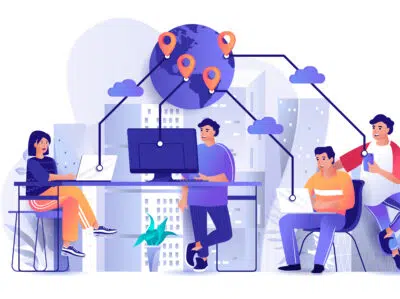How to optimise the remote worker experience

How to make workplaces more welcoming for people with disabilities
January 12, 2022
How to choose a business location: 11 crucial factors to consider
January 13, 2022
While remote working was not unheard of in pre-pandemic times, it’s becoming quite clear that the remote and hybrid environment is here to stay. The pandemic hastened a structural shift in how business is conducted across the globe, especially for roles that do not require employees to be physically present. This is likely to continue — according to a McKinsey survey, it is expected that as many as 90 percent of businesses will continue to offer remote and hybrid working. For their part, while employees have voted for remote, hybrid and flexible working, they do miss connecting with each other in a physical workspace. While remote work has improved both employee satisfaction and efficiency, it brings its own challenges. A continued uncertain environment, digital exhaustion, and isolation from a physical workspace feeds anxiety, which can lead to a potential loss in productivity. While stressed-out employees may call it quits, a shrinking and connected world makes it easy to jump jobs too. The disruption to the work environment requires companies to adopt a proactive approach to provide positive work environments to remote and hybrid employees to ensure a continued improvement in productivity, talent acquisition, and retention.
Best practices for providing a positive remote work experience
Connect with remote workers
It’s up to Human Resources (HR) to remain accessible to employees, albeit virtually. They need to communicate processes and policies to employees to avoid ambiguity. Since employees can no longer just walk down the corridor to the HR department, companies need to hold virtual sessions for remote workers. For example, information on the updated healthcare package or escalation matrix would serve well to keep employees in the know. Build a community that cuts across lines. Engaging with employees through various channels – organising informal clubs, discussions between diverse groups, sending care packages or virtual open mic sessions are a few easily implementable ideas. One of the constant challenges of working from home is the constant blurring between personal and professional time, and the consequent stress of not having any “me-time”. Companies need to support remote employees with initiatives on mental health and promote work-life balance. There is no substitute for recognition and appreciation either. A simple “Great job!”, said honestly at the right moment, works wonders to boost employee morale.Provide career development opportunities
Professional development is necessary for employee engagement and performance. This is especially true for young college graduates who do not have prior exposure to work environments. Gen Z is at particular risk of feeling lost, as they find it difficult to feel engaged with company matters, participate in conversations and offer their perspectives. Attracting and retaining new talent becomes easier when you have well-defined career development initiatives - virtual learning, fresh and lateral entrant courses, fireside chats or collaboration with universities are all ways to foster a learning community. Employee side projects are a good way of encouraging creativity and autonomy. For instance, Google has a 20 per cent side project plan that has resulted in AdSense and GMail. Other companies have implemented similar initiatives. Atlassian offers a similar plan, while MyPlanet allows 5% of working time to be devoted to professional or personal development. This has resulted in significant innovation ranging from Q&A tools to company podcast stations.
Identify workflows that work!
Workplace disruption largely means that many organisation processes that hitherto worked, may not apply in a remote and hybrid environment. Businesses should delve deep to:
- Identify bottlenecks and implement workflows that will accelerate the transformation.
- Establish metrics to understand progress.
The role of technology in optimising remote work experience
The initial chaos of work from home gave way to a more organised remote work scenario. Companies stepped up to deliver or compensate for the required physical infrastructure for remote working. Of course, none of this would be possible without technology, which has had, and will continue to have, a major impact on the overall efficiency of the remote worker.
Optimise the virtual onboarding experience:
Provide the right equipment and technology:
Standardise remote collaboration tools and technologies:
Informal employee engagement:
The new normal at the workplace necessitates the implementation of new technologies for various processes. Virtual hiring and onboarding platforms can iron out many challenges during remote hiring and onboarding, both of which have a substantial impact on the employee experience.
Identify each individual employee’s needs, and provide the right devices. For instance, somebody in the Accounts department may need a high-speed laptop, whereas a graphics designer might need an advanced machine and a special monitor. The access to the right set of business applications and data ensures that employees remain productive and can work with minimal disruption. Security policies must be reviewed, and employees must have seamless access to data, tools and technologies, but at the same time be well within the security mandates of the organisation.
Providing a consistent org-wide set of applications for collaboration and connectivity works well to give remote workers a consistent experience. Review apps and tools often to ensure that the organisation has the latest reliable applications for a connected workplace.
Break-out rooms, shout-outs via Slack or other communication tools, informal virtual lunches and coffee sessions are all possibilities offered by using the right technology.
Technology plays a vital role in employee experience for remote and hybrid workplaces, which ultimately results in better productivity and retention.
Keep it employee-centric
The success of the remote and hybrid workplace is ultimately the result of a happy and engaged remote workforce. Involve employees, and collect feedback for continuous improvement. Companies need to revise their definition of employee value proposition for the remote worker. Processes and technology should be used as enablers to create a connected and collaborative workspace that results in a satisfied and productive employee.
Saying “How was your day?” still matters - even if it’s a virtual shout-out.


